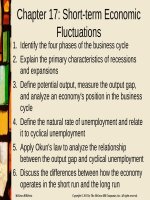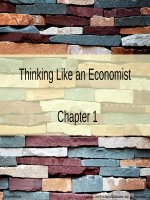Lecture Principles of economics (Asia Global Edition) - Chapter 11
Bạn đang xem bản rút gọn của tài liệu. Xem và tải ngay bản đầy đủ của tài liệu tại đây (588.41 KB, 40 trang )
The Economics of
Information
Chapter 11
McGrawHill/Irwin
Copyright © 2015 by McGrawHill Education (Asia). All rights reserved.
Learning Objectives
1.
2.
3.
4.
Explain how middlemen add value to market
transactions
Use the concept of rational search to find the
optimal amount of information market
participants should obtain
Define asymmetric information and describe
how it leads to the lemons problem
Discuss how advertising, conspicuous
consumption, statistical discrimination, and
other devices are responses to asymmetric
information
112
Information and the Invisible
Hand
•
All parties have all relevant information
–
Without free information, market results are not
efficient
•
•
Bargaining for a bowl in Kashmir
Parties must decide how much information to
gather
–
Information gathering strategies differ
113
How The Middleman Adds Value
•
Buyers sometimes choose among several
version of a product
–
•
Each has complex feature sets
Research options
–
–
–
–
Company web site
Ask friends and family
Consumer Reports, online product reviews
Visit stores, ecommerce sites
114
Consumer Choice: Buying
DSLR Camera
•
Best Denki recommends US$1,200 Nikon D7100
DSLR camera
–
•
Your next move is
–
–
–
•
Sales rep seems knowledgeable
Thank them and do more research
Trust the sales rep and buy them
Go home and buy at the best price online ($950)
Evaluate the importance of
–
–
–
Immediate possession
Best price
Post-sales service and support
115
The Value of the Middleman
•
Sales representatives supply information to
buyers
–
•
Manufacturers can offer direct sales to bypass
middlemen
Information makes markets more efficient
–
Purchasing the bowl in Kashmir
116
Selling Babe Ruth
•
Koh wants to sell a Win the War stamp.
–
–
–
–
–
His reservation price is $300
An ad in the local newspaper cost $5
eBay cost is 5% of the Internet auction price
The maximum price in the local market is $400
Two eBay shoppers have secret reservation prices
of $800 and $900, respectively
117
Selling Win the War stamp
•
Benefits of eBay
–
Card sells for $800 on eBay less $40 commission
•
•
•
Local option is inferior
–
–
–
•
Ellis nets $760, $460 above his reservation price
Buyer surplus is $100
Card sells for $400 less $5 cost of ad
Koh nets $395, $95 more than his reservation price
Buyer surplus is $0
Economic surplus is increased when a product
goes to the person who values it the most
118
The Optimal Amount of
Information
More information is better than less
–
•
Marginal benefit starts high, then falls rapidly
–
•
•
Gathering information has a cost
Low-Hanging Fruit Principle
Marginal cost starts low,
then increases
Optimal amount of
information is I* where
MC = MB
Optimal
MC
$/unit
•
MB
I*
Units of information
119
Free Rider Problem
•
A free-rider problem exists when non-payers
cannot be excluded from consuming a good
–
–
•
Interferes with incentives
Market quantity is below social optimum
Stores bear the cost of training sales reps on
merchandise
–
Shoppers use sales reps as information source
•
–
Then some shoppers buy elsewhere
Store is unable to capture some of the value it
delivered to the shopper: a free-rider problem
1110
Example: The Last Bookstore
•
Independent bookstores differentiate themselves
with personalized service
–
Offer more information and recommendations than
Barnes & Nobles or Borders
•
–
Chain bookstores carry large inventory and shopping
center location can erode local store base
Ecommerce sites such as Amazon.com and
Overstock.com offer reviews and recommendations
•
•
Large inventory; quick delivery
Online sales further reduce sales in independent
stores
1111
Rational Search Guidelines
•
Additional search time is more likely to be
worthwhile for expensive items than cheap ones
–
Apartment search in Taipei, Tawian involves less
time than Tokyo, Japan
•
•
Taipei has lower rents and narrower price range
Prices paid will be higher when the cost of a
search is higher
–
Two buyers, only one with a car
•
Buyer with the car will look at more pianos before
buying
1112
Gamble Inherent in Search
•
Additional search has costs that are certain
–
–
•
Benefits are uncertain benefits
Additional search has elements of a gamble
A gamble has a number of possible outcomes
–
Each outcome has a probability that it will occur
1113
Gamble Inherent in Search
•
The expected value of a gamble is the sum of
(the possible outcomes times their respective
probability)
–
–
A fair gamble has an expected value of zero
A better-than-fair gamble has a positive expected
value
1114
Risk Preferences
•
A risk-neutral person would accept any gamble
that is fair or better-than-fair
–
A risk-averse person would refuse any fair gamble
1115
The Gamble in the Search
•
You need a one-month sublet in Hong Kong
–
–
–
One type of apartment rents for US$400 and it is
80% of the available market
The other type rents for US$360 and makes up
20% of the market
You must visit the apartment to get the rental rate
•
–
Cost per visit is US$6
You are risk-neutral
1116
Hong Kong Apartment Search
•
•
The first apartment you visit is the US$400
version
Look at the next apartment if the gamble is at
least fair
–
Two outcomes to the gamble
•
•
–
You find a lower-priced apartment and your net
benefit is US$34 with 20% probability
You find another US$400 apartment and your net
benefit is – US$6 with 80% probability
Expected value of the gamble is
(34) (0.20) + (– 6) (0.80) = US$2
–
Keep searching
1117
Commitment Problems
and Search
•
Some searches are for circumstances requiring
commitment over some period of time
–
–
–
•
Search is costly and therefore limited
–
•
Leasing an apartment
Taking a job
Getting married
People end their searches when the marginal cost
of searching exceeds the marginal benefit
BUT… what if you fall into a better option?
1118
Commitment Problems
and Search
•
If information were freely available, there would
be no commitment problem
–
–
•
•
Contracts are used to bind parties together AND
Contracts carry penalties for breaking the
arrangement
People terminate their search because
information gathering is costly
Under some circumstances, one party may
rationally choose to terminate the agreement
and pay the penalties
1119
Asymmetric Information
•
Asymmetric information occurs when either the
buyer or seller Is better informed about the
goods in the market
–
–
Mutually beneficial trades
may not occur
A seller might know that
a murder was committed in a
house offered for sale
•
Buyer does not know
1120
Private Sale of a Used Car
•
Akari's Miata is in excellent condition
–
Akari reservation price is $10,000
•
•
Haruto wants to buy a Miata
–
–
–
•
Blue Book value is $8,000
His reservation price is $13,000 for one in excellent
condition and $9,000 for one in average condition
Determining the condition of Akari's car has a cost
and the results are uncertain
Haruto cannot verify that Akari's Miata is superior
Haruto buys another Miata for $8,000; Akari's is
unsold
1121
Surplus Loss and Asymmetric
Information
•
Haruto's loss is $1,000
–
–
Pays $8,000 and has a gain of $1,000
Haruto’s loss from buying an average car instead of
Akari's
•
$13,000 – $11,000 = $2,000
–
•
•
Haruto's net loss is $1,000
Akari’s loss from losing Haruto as a customer is
$1,000
Total loss is $2,000
1122
The Lemons Model
•
People who have below average cars (lemons),
are more likely to want to sell them
–
•
Good quality cars are withdrawn from the market
–
•
Buyers know that below average cars are likely to
be on the market and lower their reservation prices
Average quality decreases further and reservation
prices decrease again
The lemons model says that asymmetric
information tends to reduce the average quality
of goods for sale
1123
The Lemons Model in Action
•
Your aunt offers you her 4-year old Accord
•
•
•
•
The asking price of $10,000 is the blue book value
You believe the car is in good condition
Blue book value is the equilibrium price for
below average cars
You should buy the car for $10,000
–
It is in better condition than the average Accord of
the same vintage and mileage
1124
Naïve Buyer
•
Two kinds of cars: good cars and lemons
–
–
–
Owners know what kind they have
Buyers can't determine a car's quality
Buyers are risk neutral
Probability
Value
•
Good Cars
Lemons
90%
$10,000
10%
$6,000
What would the buyer offer for a used car?
–
Expected value of a car is
(0.90) ($10,000) + (0.10) ($6,000) = $9,600
•
The buyer gets a lemon
1125









